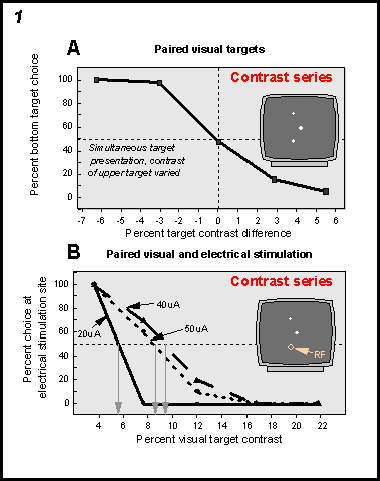Visual Prosthesis
B. The visual percept elicited by electrical stimulation of area V1
 Figure
1A shows performance in a monkey when two visual targets were
presented, one in the upper and the other in the lower visual field as
indicated in the inset. Plotted are the percent of choices made to the
lower target (Y axis) as a function of the contrast of the visual stimulus
(X axis). The equal probability choice for the upper and lower target
occurs when the two stimuli have the same contrast. In Figure
1B data are shown under conditions when instead of the lower
target electrical stimulation is applied in concert with the upper visual
target. The area stimulated contains neurons whose receptive fields were
located in the same region as where the lower visual target had been presented
in A. Data were collected in blocks using three different current levels
of electrical stimulation. The data show that the visual stimulus which
elicited an equivalent choice occurred when the visual target had a rather
low contrast. The point at which there was equivalence between the visual
target and the electrical stimulation shifted to higher contrasts with
increasing current but only over a small range (between 5 and 10 percent
contrast). Thus it appears electrical stimulation in the monkey under
our conditions produces a rather weak, low contrast percept. Figure
1A shows performance in a monkey when two visual targets were
presented, one in the upper and the other in the lower visual field as
indicated in the inset. Plotted are the percent of choices made to the
lower target (Y axis) as a function of the contrast of the visual stimulus
(X axis). The equal probability choice for the upper and lower target
occurs when the two stimuli have the same contrast. In Figure
1B data are shown under conditions when instead of the lower
target electrical stimulation is applied in concert with the upper visual
target. The area stimulated contains neurons whose receptive fields were
located in the same region as where the lower visual target had been presented
in A. Data were collected in blocks using three different current levels
of electrical stimulation. The data show that the visual stimulus which
elicited an equivalent choice occurred when the visual target had a rather
low contrast. The point at which there was equivalence between the visual
target and the electrical stimulation shifted to higher contrasts with
increasing current but only over a small range (between 5 and 10 percent
contrast). Thus it appears electrical stimulation in the monkey under
our conditions produces a rather weak, low contrast percept.
|